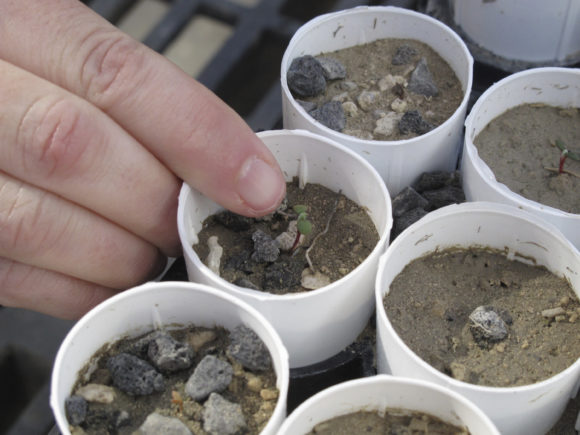RENO, Nev. — State and federal authorities are investigating the mysterious loss of a significant swath of a rare desert wildflower that’s being considered for federal protection at a contentious mine site in Nevada with some of the largest untapped lithium deposits in the world.
The Australian mining company, Ioneer Ltd., and state biologists investigating the unprecedented incident believe small mammals most likely caused the damage to thousands of plants at the only place Tiehm’s buckwheat is known to exist.
Conservationists suspect a more sinister scenario: Somebody dug them up while federal wildlife officials consider listing the plant as an endangered species.
Nevada’s Department of Conservation and Natural Resources, U.S. Bureau of Land Management and Fish and Wildlife Service are investigating.
“While the investigation is still underway and the cause has yet to be determined, the evidence reported to us is consistent with herbivore activity,” department spokeswoman Samantha Thompson said in an email to The Associated Press.
Thompson said the agency isn’t aware of any similar instance involving Tiehm’s or related species. She said there were no reports of tool marks.
The Center for Biological Diversity, which petitioned to list the plant earlier this year, reported “mass destruction” at the site about 200 miles (320 kilometers) southeast of Reno to state and federal officials Tuesday.
It estimates as many as 17,000 plants were lost — up to 40% of the entire population.
Patrick Donnelly, the center’s Nevada director, and Naomi Fraga, director of conservation at the California Botanic Garden in Claremont, discovered and photographed the damage Sept. 13. They believe the plants were removed with small shovels or spades.
“This appears to have been a premeditated, somewhat organized, large-scale operation aimed at wiping out one of the rarest plants on Earth, one that was already in the pipeline for protection,” Donnelly said.
He wasn’t aware at the time that researchers at the University of Nevada, Reno had observed the same phenomenon Sept. 8 and reported it to the Nevada Department of Conservation and Natural Resources’ Division of Natural Heritage.
Elizabeth Leger, a UNR biology professor leading a research effort to try to transplant the wildflower , is among those who suspect small animals caused the damage at the site of the proposed mine with a projected value of more than $1 billion.
“The impact on the plants is very alarming, no matter what the cause,” said Leger, who directs UNR’s Museum of Natural History.
Ioneer executive chairman James Calaway doubts anywhere near 17,000 plants were impacted but said it could be in the “low thousands.”
He accused the Center for Biological Diversity of spreading “outlandish, false, inflammatory and irresponsible” statements about possible human involvement.
“It was some rodents that got hungry and thirsty,” Calaway said.
“We all agree it is a tragic event. We are out there working our tails off to try to understand what happened … and take steps to make sure it doesn’t happen again,” he said. “It shows that CBD and Patrick Donnelly are willing to literally say anything in order to stop the development of this project.”
Fraga, a co-signer of the federal listing petition, has never heard of buckwheats “being uprooted by a freak rodent attack.”
“I find it hard to believe that two species — buckwheat and rodent — that have lived at the same site for presumably for decades, centuries or even longer have an interaction that is catastrophic for the buckwheat for the first time at a time when protection of the species and the site is under serious scrutiny,” she said.
The center is urging the government and Ioneer to take steps to protect the remaining population, including fencing the site and posting a 24-hour security guard. It wants USFWS to immediately declare the flower endangered and Nevada to adopt rules to protect it.
Skeptics of the rodent theory include Benjamin Grady, an assistant biology professor at Ripon College in Wisconsin who wrote a technical report for the USFWS on buckwheat in 2015 and heads a national association of scientists who study the genus.
Grady, president of The Erogonum Society, said Tiehm’s has been monitored since the early 1990s “and to the best of my knowledge, damage like this has never been reported.” He hasn’t seen the damage first-hand but has been to the site numerous times and studied photographs of the damage.
“I have visited hundreds of different wild buckwheat populations from Colorado to California and New Mexico to Montana and have never seen herbivore damage anywhere close to this severe,” Grady said in an email to AP. “It seems very likely that this event was a deliberate human action.”
Dan Barton, chairman of the Wildlife Department at California’s Humboldt State University who has studied rodents and rare plants in similar soils for seven years, said the photographs and observations don’t “appear consistent with any rodent damage I’ve ever seen.”
Calaway believes drought conditions could have played a role.
“We’ve never seen anything like that in the five years we have been out there,” he said. He said they observed rodent activity about six weeks ago in a small patch of plants they’ve been watering in an effort to bolster the population _ “but not on this scale.”
The company has spent more than $1 million on conservation efforts at the site rich with lithium needed to manufacture such things as batteries for Tesla’s electric cars. It has also entered into a multiyear research agreement with UNR scientists to study the possibility of transplanting buckwheat grown in a campus greenhouse to the wild.
Calaway said it’s too soon to know but anticipates they’ll remain on schedule to get permits begin construction by next summer.
“We are in the investigative phase of these animal attacks and trying to understand it in a thorough way,” he said. “We don’t at this time really see any reason why it would slow down or change the timeline.”
About the photo: Beth Leger, a plant ecologist at the University of Nevada, Reno, points to a tiny Tiehm’s buckwheat that has sprouted at a campus greenhouse in this photo taken on Feb. 10, 2020 in Reno, Nevada. Their research is being funded by an Australian mining company that wants to mine lithium in the high desert 200 miles southeast of Reno, the only place the rare wildflower is known to exist in the world. UNR researchers are studying whether they can transplant the plant or seeds germinating in the greenhouse to the desert to bolster the native population. (AP Photo/Scott Sonner)
Was this article valuable?
Here are more articles you may enjoy.


 We Have Entered A New Era of Auto Claims Complexity
We Have Entered A New Era of Auto Claims Complexity  Citi Reverses Course on Firing of Japan Trader Five Years On
Citi Reverses Course on Firing of Japan Trader Five Years On  Hackers Abuse Modified Salesforce App for Data Theft and Extortion, Google Says
Hackers Abuse Modified Salesforce App for Data Theft and Extortion, Google Says  Delivery Hero Hit by $376 Million Fine for Glovo Cartel
Delivery Hero Hit by $376 Million Fine for Glovo Cartel 